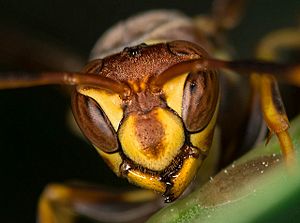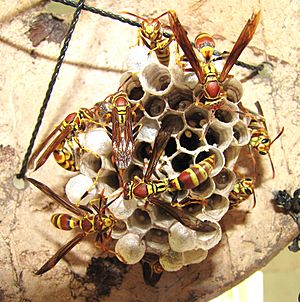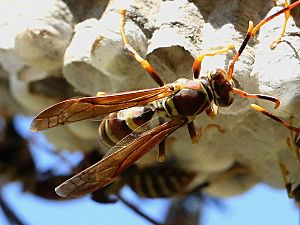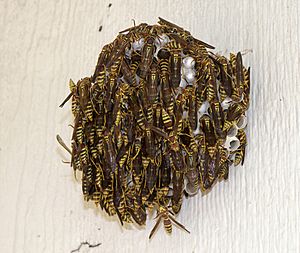Guinea paper wasp facts for kids
Quick facts for kids Guinea paper wasp |
|
|---|---|
 |
|
 |
|
| Scientific classification | |
| Synonyms | |
|
The Polistes exclamans, also known as the Guinea paper wasp, is a social wasp. This means they live in organized groups, much like bees. They belong to the Vespidae family, which is part of the larger insect group called Hymenoptera. You can find these wasps across the United States, Mexico, the Bahamas, Jamaica, and even parts of Canada.
In recent years, the Guinea paper wasp has spread its territory, especially across the eastern and northern United States. Scientists think this might be because of changes in global climate. A P. exclamans colony has three main types of wasps: males, workers, and queens. Interestingly, the older a wasp is, the more important it is in the colony's pecking order. Usually, one queen lays all the eggs in the nest.
Workers and queens look very similar, making it hard to tell them apart without special tests. However, male wasps are easy to spot because they look different. P. exclamans wasps build open, paper nests, which makes them easy targets for animals that want to eat them or parasites that want to live off them. To stay safe, these wasps have special ways to defend themselves and recognize who belongs in their nest.
Contents
What is a Guinea Paper Wasp?
The Polistes exclamans is a type of paper wasp, part of a large group called Polistinae. This group is the second biggest of six wasp families and includes about 950 different kinds of social wasps. All paper wasps live in groups.
P. exclamans belongs to the Polistes genus, which is divided into four smaller groups found worldwide. Our Guinea paper wasp is part of the Aphanilopterus group, found in the New World (North and South America). It is closely related to other wasps like P. annularis and P. canadensis.
How to Identify a Guinea Paper Wasp
There are two main types of Polistes exclamans in the United States: the typical form and the variable form.
Typical Form
The typical form is found in the southeastern United States, in states like North Carolina, Florida, and Texas. These wasps usually have some yellow coloring, though the exact shade can change. They often have four yellow stripes on their middle body section (called the propodeum) and yellow lines on their upper back (mesonotum). Their heads might also have yellow marks. Their wings are not yellow but are a smoky, purple color. This form can sometimes be mistaken for other wasps like Polistes fuscatus.
Variable Form
The variable form is reddish-brown. Its wings and certain parts of its legs and antennae are dark or black. Instead of yellow, this form has pale, ivory-white marks spread across its body.
Special Features
P. exclamans wasps have antennae with bands of red, black, and yellow. Most other paper wasps only have one color on their antennae. Female wasps have front wings that are about 13 to 16.5 millimeters long. Males have slightly shorter front wings, about 12 to 15 millimeters long.
While female workers and queens look very much alike, male wasps are easy to identify. They have bulging eyes, a square-shaped face plate (clypeus), and thin antennae. Male wasps also show more differences in their looks than females.
Where Guinea Paper Wasps Live and Build Nests
You can find Polistes exclamans across many parts of the United States, from New Jersey down to Florida, and west to Nebraska, Colorado, Arizona, and California. They also live in Mexico, the Bahamas, and even Ontario, Canada.
Nests and Homes
P. exclamans wasps build their nests out of paper. These nests usually have a single layer of open cells, like a honeycomb. While the size of the nest can vary, they can have up to 500 cells. Unlike some other wasps, P. exclamans nests do not have an outer paper covering. The nests are usually round and hang from a single support, often with the oldest cells near the top.
These wasps are good at starting new colonies because the founding queens often spread out into new areas. They often build nests near human-made structures, like buildings, and prefer bright, open spots. They can even use bundles of straws as artificial nests.
The Wasp Life Cycle
The life cycle of Polistes exclamans is longer than wasps in colder northern areas but shorter than those in tropical places. Their cycle typically runs from March to September.
From Egg to Adult
The first group of worker wasps appears between May and July. It takes about 9 to 14 days for an egg to hatch. Larvae (young wasps) then take about 13 to 18 days to grow, and pupae (the stage before adult) take about 13 days. In total, it takes about 6 to 8 weeks for an egg to become an adult wasp. New queens and males, who will reproduce, emerge later in August or September.
The Queen Wasp
P. exclamans colonies have a social structure with one queen who lays all the eggs.
What Makes a Queen Special?
All female wasps in the colony look the same, and any female can become a queen and lay eggs if needed. This raises the question: how is a queen chosen?
Studies show that queens and males have higher levels of certain sugars like glucose and fructose than workers. These sugars act like a natural "antifreeze," helping them survive in colder weather. Queens have a much higher survival rate in cold temperatures (about 76%) compared to workers (about 17%). Queens also have a small layer of fat around their bodies, which helps them live longer into winter and possibly extend their mating season. Only queens seem able to go into a deep sleep (diapause) during winter.
How a Queen Develops
While queens and workers don't look very different on the outside, there are internal signs of their social status. It seems that a wasp's role (queen or worker) is set very early in its life by the temperature it experiences while growing. For example, wasps raised in warmer, brighter conditions tend to have more active ovaries, making them more likely to become queens. This might be due to certain hormones or environmental factors that control the development of their ovaries.
The Oldest Becomes Queen
Wasp nests can sometimes be destroyed, or the queen might die. When this happens, the colony needs a new queen. The system they use is called "gerontocracy," which means "rule by the old." The oldest female worker in the colony usually becomes the new queen. This is also linked to the colony's dominance system: older wasps are higher in rank and tend to be more aggressive and better at finding food. When the queen is gone, the next oldest worker steps up. This helps keep the colony's family ties strong, as the new queen is often closely related to the other adult workers.
What Does the Queen Do?
P. exclamans nests are usually smaller than those of other wasps, often with fewer than 100 individuals. Because of the nest's size, the queen is usually the busiest wasp. She has to keep an eye on everything and control the activities of the nest. Besides laying eggs, the queen also helps to keep the workers' activities in sync. She has even been seen acting aggressively towards workers who are not active enough.
Wasp Reproduction and Family Life
P. exclamans wasps have a special way of determining sex called haplodiploidy. This means that males develop from unfertilized eggs and have only one set of chromosomes (haploid). Females develop from fertilized eggs and have two sets of chromosomes (diploid).
Early Males in the Colony
The first group of workers appears between May and July. At the same time, some reproductive males, called "early males," also emerge. These early males are very helpful for the colony. Nests with more early males tend to produce more workers, cells, and new wasps.
Queen deaths are common in Polistes exclamans, especially in May. Most original queens are gone by July, long before the eggs that will become the next generation of reproductive wasps are laid. So, if a queen dies, the oldest former worker becomes the new queen. The early males help ensure the colony can continue even if the original queen dies.
Wasp Behavior and How They Live
Polistes exclamans nests are relatively small. This means they are more likely to be destroyed by predators, parasites, or if too many workers die. Because of this, it's helpful for female wasps to be able to change their role.
Workers Can Become Queens
Scientists thought that Polistes exclamans workers might act as workers if there were young wasps (brood) to care for, but if there were no young, they might start developing queen-like features. This idea turned out to be true. In an experiment, when eggs and larvae were removed from a group of wasps, the female wasps started to act like future queens and even developed the fat layer that queens have. Wasps in a control group, where the young were present, continued to act as workers. This shows that the presence of young wasps affects whether a female becomes a worker or a queen.
Recognizing Family Members
Many social insects can tell their nestmates apart. Polistes exclamans wasps can even tell relatives from non-relatives, even if they've been raised in the same environment. In one study, wasps from different nests were put together after living in identical conditions. The wasps formed more clumps when there were more unrelated groups, showing they could recognize their family. This ability helps them defend their nest.
Winter Sleep (Hibernation)
Many Polistes species gather together during winter. Polistes exclamans wasps form large groups when they hibernate. They often find protected spots like cracks in rocks, under tree bark, or between building walls. These spots are called hibernacula and offer protection during the cold months.
Worker Lifespan
A typical P. exclamans worker lives for about 14 to 16 days. The oldest wasp ever seen in a natural colony lived for 102 days. Queens usually live about six times longer than workers. The lifespan of wasps can vary depending on their colony. Wasps that fly outside the nest often to find food (foragers) tend to have shorter lives because their job is riskier. However, colonies with many foragers also tend to have more young wasps to make up for the shorter lifespans.
Worker deaths are a big reason why colonies fail, causing 13% to 76% of colony failures. Because these colonies are small, workers living longer is very important for the nest to survive.
Expanding Their Territory
From the 1950s to the 1960s, Polistes exclamans wasps spread into the midwestern United States. New records of these wasps were found in states like Illinois, Indiana, and Maryland. This expansion might be because P. exclamans queens are very good at starting new nests alone and spreading out into new areas. Wasps that start nests with other wasps tend to stay closer to their original home.
Building Satellite Nests
It's common for P. exclamans to build smaller "satellite" nests. A queen might fly a short distance (from 0.15 to 11 meters) from the main nest to start a new one. About 16% to 39% of nests create satellites between May and July.
These satellite nests act like an insurance policy against attacks from predators (animals that eat them) and parasitoids (insects that lay eggs inside them). For example, if birds knock down a main nest, about 66.7% of colonies with satellites survive by moving to the satellite, compared to only 5.7% of colonies without satellites. Satellite nests also help when certain parasites like Elasmus polistis attack.
Older workers often start satellite nests and have more developed ovaries. Younger workers join the satellite nest after it's built. The number of workers in both the main and satellite nests is important for both to survive. Sometimes, the main nest can even be abandoned after a few months. If not enough workers follow the first worker to the new nest, the satellite nest will likely fail.
How Guinea Paper Wasps Interact with Other Species
Polistes exclamans wasps live in open nests, which makes them easy targets for predators and parasitoids. Parasitoids are insects that lay their eggs inside another insect's body or nest.
Parasitoid Attacks
The two most common parasitoids are the moths Chalcoela iphitalis and Elasmus polistis.
C. iphitalis and E. polistis Moths
P. exclamans wasps have ways to fight back. If they sense an intruder like the C. iphitalis moth, they will bite and sting the area where the moth passed. This causes the nest to vibrate, and the wasps inside will move around quickly. This is called the "parasite dance" and can last up to 10 hours. If a moth is found, it's eaten right away. However, this doesn't happen often. The moth lays its eggs in the nest, and when they hatch, they take over, causing many wasp pupae to die. This is common in late summer when the moth is most active.
The Elasmus polistis parasitoid also causes big problems. Up to 80 E. polistis can hatch from a single wasp cell. The male moths emerge first, then wait for the females. Once the females appear, they mate and reproduce, quickly destroying the P. exclamans population. Sometimes, E. polistis larvae hide in the nest, making them hard for the wasps to find. Wasps try to remove as many parasitoids as possible to stop them from spreading. However, this defense often isn't very effective. In one study, over 60% of all nests lost young wasps to these parasitoids. Larger satellite nests are more likely to be attacked because they are usually older.
Predator Attacks
P. exclamans wasps have several predators. Birds are very dangerous because they can fly by and knock the entire nest to the ground. When this happens, the adult wasps fly away, often to another colony or a satellite nest. Birds also eat the young wasps (larvae) from the nest.
Ants, like Crematogaster laeviuscula, attack differently. Instead of knocking down the nest, they swarm over it and carry away all the young wasps. The ants destroy the entire brood but usually don't kill the adult wasps.
Other predators attack adult wasps when they are out looking for food or traveling to satellite nests. It's hard to know how many adults are killed away from the nest. However, a queen's flight to a satellite nest doesn't seem to put her in much danger.
How Wasps Defend Their Colony
Facial Patterns for Defense
Some animals use certain features to show how strong they are in a fight. Polistes exclamans wasps use the patterns on their faces to show how good they are at competing. Larger wasps have more brown coloring on their faces (clypei). Wasps use these colored patterns to decide if they should challenge another wasp. The more coloring a wasp has, or the larger it is, the more likely it is to challenge a rival. If a wasp has less coloring or is smaller, it's less likely to challenge. This helps reduce fights between queens who are trying to start new nests.



